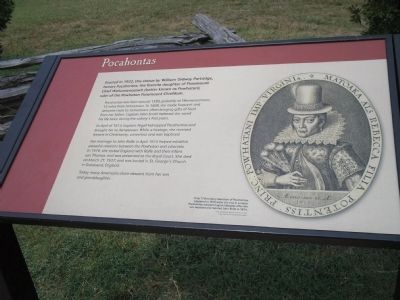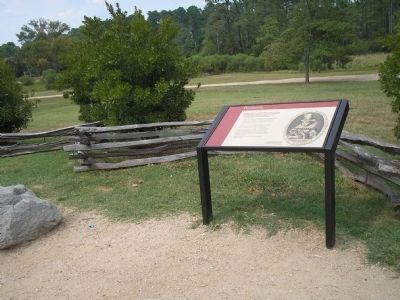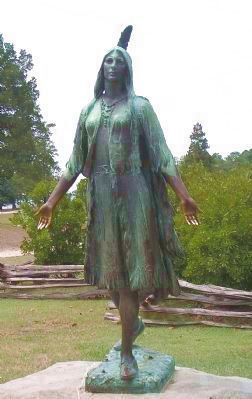Williamsburg in James City County, Virginia — The American South (Mid-Atlantic)
Pocahontas
Pocahontas was born around 1595, probably at Werowocomoco, 15 miles from Jamestown. In 1608, she made frequent and welcome visits to Jamestown, often bringing gifts of food from her father. Captain John Smith believed she saved his life twice during the colony’s first years.
In April of 1613, Captain Argall kidnapped Pocahontas and brought her to Jamestown. While a hostage, she received lessons in Christianity, converted, and was baptized.
Her marriage to John Rolfe in April 1614 helped establish peaceful relations between the Powhatan and colonists. In 1616, she visited England with Rolfe and their infant son Thomas, and was presented to the Royal Court. She died on March 21, 1617, and was buried in St. George’s Church in Gravesend, England.
Today, many Americans claim descent from her son and granddaughter.
Erected by Colonial National Historical Park, National Park Service.
Topics. This historical marker is listed in these topic lists: Churches & Religion • Colonial Era • Native Americans • Women. A significant historical month for this entry is March 1849.
Location. 37° 12.524′ N, 76° 46.7′ W. Marker is in Williamsburg, Virginia, in James City County. Marker can be reached from Colonial Parkway, on the right when traveling west. Marker is in the "Old Towne" section of the Historic Jamestown unit of Colonial National Historic Park. Touch for map. Marker is in this post office area: Williamsburg VA 23185, United States of America. Touch for directions.
Other nearby markers. At least 8 other markers are within walking distance of this marker. Jamestown (a few steps from this marker); Fort Extension, Blockhouse (a few steps from this marker); Jamestown’s Churches (a few steps from this marker); The Tombstones (within shouting distance of this marker); The Tombs of James and Sarah Blair (within shouting distance of this marker); 1608 Church (within shouting distance of this marker); Church Tower (within shouting distance of this marker); Storehouse & First Well (within shouting distance of this marker). Touch for a list and map of all markers in Williamsburg.
More about this marker. The right of the marker contains the “Only 17th-century depiction of Pocahontas, engraved in 1616 when she was in London. Pocahontas adopted English lifestyles after she was baptized and married John Rolfe in 1614. Simon Van de Passe, Matoaka alias Rebeecca, 1616. Courtesy of the Virginia Historical Society, Richmond Virginia.”
Also see . . .
1. Historic Jamestowne. Colonial National Historic Park from National Park Service website. (Submitted on September 11, 2008, by Bill Coughlin of Woodland Park, New Jersey.)
2. Historic Jamestowne. Historic Jamestowne is the site of the first permanent English settlement in America. The site is jointly administered by APVA Preservation Virginia and the National Park Service. (Submitted on September 11, 2008, by Bill Coughlin of Woodland Park, New Jersey.)
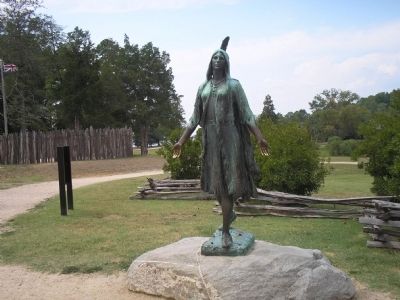
Photographed By Bill Coughlin, August 14, 2008
4. Statue of Pocahontas
The statue was commissioned by the Association for the Preservation of Virginia Antiquities and was first exhibited in Norfolk at the “New York at the Jamestown Exposition” in 1907. It was dedicated in 1922 when it was installed on Jamestown island, and was moved to its present location in 1931.
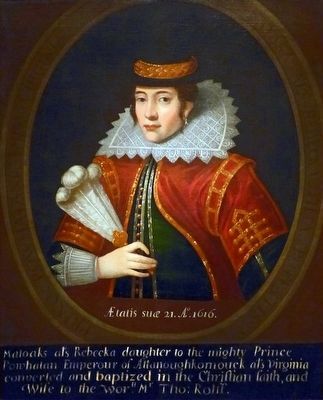
Photographed By Allen C. Browne, February 16, 2015
5. Pocahontas, age 21, 1616
This portrait of Pocahontas (Matoaks) after a 1616 engraving by Simon van de Passe hangs in the National Portrait Gallery in Washington DC.
Ætatis suæ 21. Ao. 1616.
Matoaks als Rebecka daughter to the mighty Prince Powhatan Emperour of Attanoughkomouck als Virginia converted and baptized in the Chriƒtian faith, and Wife to the worʰ. Mr Tho: Rolff.
“Pocahontas, the Indian princess who allegedly saved the life of English colonist John Smith, survives and flourishes as an example of an early American heroine. While Smith may have embellished the story of his rescue, the importance of Pocahontas to relations between colonists and Native Americans is undisputed. Following her conversion to Christianity and marriage to Englishman John Rolfe, Pocahontas journeyed to England with her family to demonstrate the ability of new settlers and native tribes to coexist in the Virginia colony. While in England, Pocahontas sat for her portrait, which was later engraved. That print served as the basis for this later portrait. The painter included an inscription beneath the likeness, copied from the engraving, but through an error in transcription it misidentifies her husband as Thomas, the name given to their son.” — National Portrait Gallery
Ætatis suæ 21. Ao. 1616.
Matoaks als Rebecka daughter to the mighty Prince Powhatan Emperour of Attanoughkomouck als Virginia converted and baptized in the Chriƒtian faith, and Wife to the worʰ. Mr Tho: Rolff.
“Pocahontas, the Indian princess who allegedly saved the life of English colonist John Smith, survives and flourishes as an example of an early American heroine. While Smith may have embellished the story of his rescue, the importance of Pocahontas to relations between colonists and Native Americans is undisputed. Following her conversion to Christianity and marriage to Englishman John Rolfe, Pocahontas journeyed to England with her family to demonstrate the ability of new settlers and native tribes to coexist in the Virginia colony. While in England, Pocahontas sat for her portrait, which was later engraved. That print served as the basis for this later portrait. The painter included an inscription beneath the likeness, copied from the engraving, but through an error in transcription it misidentifies her husband as Thomas, the name given to their son.” — National Portrait Gallery
Credits. This page was last revised on December 25, 2019. It was originally submitted on September 11, 2008, by Bill Coughlin of Woodland Park, New Jersey. This page has been viewed 1,967 times since then and 37 times this year. It was the Marker of the Week April 3, 2011. Photos: 1, 2, 3, 4. submitted on September 11, 2008, by Bill Coughlin of Woodland Park, New Jersey. 5. submitted on October 26, 2015, by Allen C. Browne of Silver Spring, Maryland.
